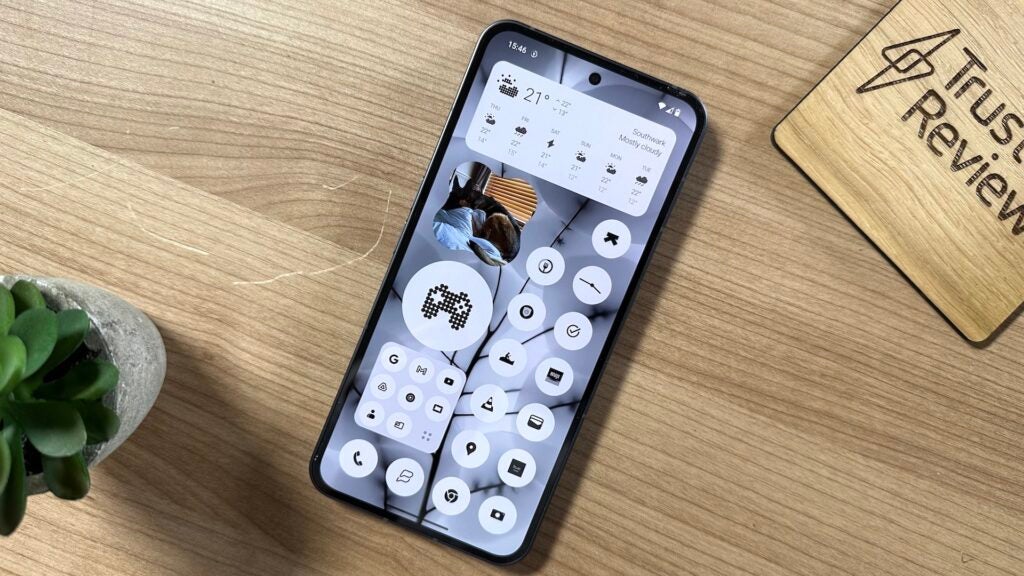Nothing CMF Phone 1 vs Nothing Phone 2: What’s the difference?

Nothing has revealed the CMF Phone 1, the latest budget phone from the affordability-focused subbrand, but how does it compare to the full-fat Nothing Phone 2?
While there are plenty of differences given that the CMF Phone 1 costs just £209 while the Nothing Phone 2 retails at £579, there are also a few key areas – like software – where the two phones don’t differ all that much.
So, the question, is, what’s the difference between the Nothing CMF Phone 1 and Nothing Phone 2?
The Nothing Phone 2 is way more powerful
Given the stark difference in price point between the two phones, it shouldn’t come as much surprise to learn that the Nothing Phone 2 is the more powerful of the two.
More specifically, the Nothing Phone 2 sports the flagship-level Snapdragon 8 Plus Gen 1, coupled with 8- or 12GB of RAM and either 128-, 256- or 512GB of storage. Though the flagship chipset is a few years old at this point, first appearing in phones in mid-2022, it still delivers strong everyday performance, as noted in our review, as well as being able to handle demanding 3D games.

The Nothing CMF Phone 1, on the other hand, sports the MediaTek Dimensity 7300 with either 6- or 8GB of RAM and either 128- or 256GB of storage.
Granted, the Dimensity 7300 does deliver impressive performance for the price, with benchmarks beating similarly priced phones like the TCL 40 Nxtpaper and more expensive options like the Moto G84 5G, and we found that it could handle casual gaming, but it wasn’t a completely lag-free experience, even when swiping through the interface.
The Nothing CMF Phone 1 has a unique modular design
One of the most unique aspects of the CMF Phone 1 is its modular design – particularly at such a budget price point. The phone is designed so that the rear cover can be completely removed, ideal not only if you scratch or damage your case but if you want to change up the look of the phone without buying a chunky case.
It also means that it’s easier to access the internals than most of the competition, the regular Nothing Phone 2 included, though modules like the camera and battery aren’t as easily removable as they are on the likes of the Nokia G22.


There’s also an Accessory Point in the bottom right that allows you to attach accessories like a kickstand or lanyard to the rear of the phone.
That’s not to say that the Nothing Phone 2’s design is naff – the transparent nature of the phone means it’s visually appealing, and with the company’s iconic Glyph interface syncing with music playback, notifications and more, it’s one of the more unique offerings around – but the CMF Phone 1 is certainly unique in the wider smartphone market.
The Nothing CMF Phone 1 only has one usable rear camera
It’s arguable that the CMF Phone 1 truly shows its budget focus in the camera department, sporting a 50MP main rear camera alongside a 2MP depth sensor. No ultrawide, no macro lens, nothing like that, just essentially one camera and an assisting lens for portrait photography.
Thankfully it’s a pretty decently specced lens, with a fairly wide f/1.8 aperture that lets in decent amounts of light and also delivers a pretty soft bokeh without the need for a dedicated Portrait mode. It’s not quite as capable at night, however, and the lack of secondary lenses means that the phone relies on digital zoom to get you closer to the action.

While the regular Nothing Phone 2 also relies on digital zoom to get closer to the action, the OIS-enabled main f/1.7 50MP camera is accompanied by a matching 50MP 114-degree ultrawide lens to deliver a more versatile shooting experience.
It’s a similar story in the selfie camera department, with the Nothing Phone 2’s 32MP selfie camera clocking in at double the 16MP of the CMF Phone 1.
Both have the same stylised Nothing OS interface
While there are differences in hardware between the two smartphones, the software experience should be consistent, with both sporting Nothing’s Nothing OS on top of Android 14.
It’s a very heavily stylised user interface that you’ll either love or hate, complete with dot matrix-style graphics, a monochrome colour scheme and a surprisingly wide range of Nothing-designed widgets that also suit the aesthetic.
Of course, there are minor differences, like the ability to create soundtracks that sync with the Glyph interface of the Nothing Phone 2, but generally speaking, you’ll get the same experience regardless of the phone you opt for.

The only key difference is long-term software support, with the cheaper CMF Phone 1 offering just 2 OS upgrades and three years of security patches compared to the three OS upgrades and four years of security patches from the Phone 2.
The Nothing CMF Phone 1 is way cheaper
As we’ve alluded to throughout this comparison, Nothing’s CMF Phone 1 is way cheaper than the Nothing Phone 2, with the former starting at £209 with 128GB of RAM and 6GB RAM while the latter retails for £579 with 8GB RAM and 128GB storage. Both are also available in higher-tier storage and RAM options.
Both the Nothing CMF Phone 1 and Nothing Phone 2 are available to buy from the Nothing Store right now, with the CMF Phone 1 due to ship starting 12 July 2024









